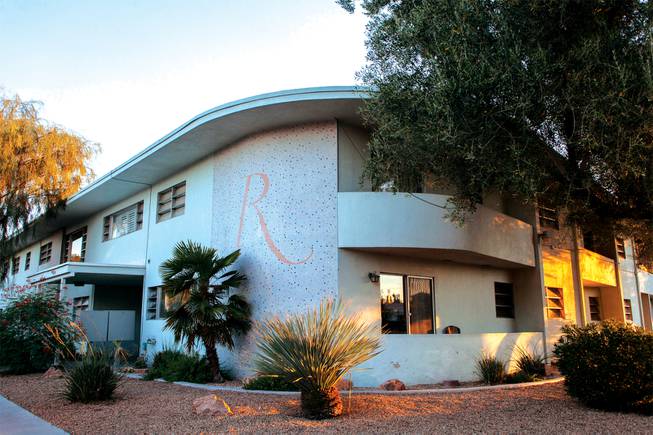
The Rexford, an apartment complex built in 1958, is on the Nevada Preservation Foundation’s Home & History Tour. And it’s part of the Beverly Green neighborhood, which is up for historic designation.
Monday, Aug. 15, 2016 | 2 a.m.
There’s a place in Las Vegas where postal workers still deliver mail door to door, where towering trees cast shadows across large yards hugging houses in spring shades of pink, blue and green — a tapestry that, despite its oddities, feels harmonious.
Never stray from a major thoroughfare, and you’ll miss it.
These neighborhoods east of Las Vegas Boulevard buck the city’s love affair with newness. Older than 50 years, the homes conjure an era when families gathered in the street to watch mushroom clouds rise from the desert. Casinos were sprouting, and the growing postwar community needed places to live out the American dream. While much of the original Strip has been razed, these vessels of wood, plaster and classic design remain.
“We will never have a building from the 1800s, but the only reason cities like Los Angeles and Boston and Chicago look the way they do is because at some point, someone said, ‘Hey, that building is now 50 years old,’” said Heidi Swank, founding director of the Nevada Preservation Foundation.
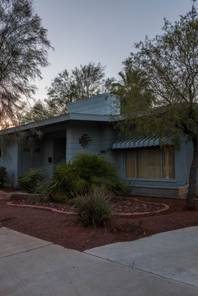
A well-preserved house in the Beverly Green neighborhood in the shadow of the Stratosphere.
Swank said that before the foundation’s launch nearly three years ago, Las Vegas — the fastest-growing metropolitan area in the 1990s — was one of only a few U.S. cities without a nonprofit group dedicated to preservation efforts. That might make sense to those who think the city is just implosions on the Strip and explosions of stucco suburbia. But with two full-time employees, 240 members and a bevy of volunteers, the foundation is educating away that myth.
“It’s not all about cool buildings,” Swank said. “It’s about buildings that embody our history.”
• • •
Recent preservation efforts in Southern Nevada have focused on neighborhoods built during or right after World War II, as they harbor midcentury modern architecture or earlier styles and echo a pivotal era in Las Vegas.
The value is less about any individual home and more about the collective feeling. Front porches. Carports. Decorative breeze block. Wood siding embellished with stone and brick. Intricate metal fences lining front yards.
Not every house is immaculately kept or a mirror of the past. Many are, but they might share the sidewalk with one sporting a Japanese theme complete with a lawn pagoda. Still, nostalgia persists. “We can look at this neighborhood and say, ‘There were people who lived here in the 1950s … People of our past,” Swank said.
Residents in a slice of ’60s-era Paradise Palms (the region’s first master-planned community and home to many famous Las Vegans back then) are seeking designation as Clark County’s first historic neighborhood. Nearby, residents in an area known as Beverly Green are trying for the Las Vegas Historic Property Register.
This month, the Las Vegas Planning Commission approved a request from the Beverly Green Neighborhood Association to become a historic district. The final step would be approval from the City Council at a meeting Sept. 21.
If it clears that hurdle, Beverly Green will become the second neighborhood to earn the designation since John S. Park did in 2003. Beverly Green sits mere blocks from the Stratosphere, bound by Oakey Boulevard to the north, St. Louis Avenue to the south, Rexford Drive to the west and Sixth Street to the east. Drive through and you’ll find ranch homes with striking rooflines — pitched, sloping, asymmetrical — and wider footprints, front porches and decorative concrete blocks, all textbook midcentury.
All but two houses in the area were built between 1951 and 1964, and many retain the look of that era. Adding to the appeal, residents say, is the fact that most of the homes were custom. “The real hallmark of vintage Vegas is that even if (properties) were built as tract houses, 60 years later, they don’t look like the house next door,” said Jack LeVine, a member of the Historic Preservation Commission and a real estate agent specializing in the charming residential side of old Las Vegas.
Swank lives in a Beverly Green home designed by Hugh Taylor, the architect behind the now-demolished Desert Inn. “I often say I live in Mayberry, because it’s the kind of place where you know everyone on the block,” she said.
That atmosphere can ripple. From May through July, one robbery, one burglary and several disturbance-related issues were reported to Metro Police in Beverly Green, according to the department’s Crime Mapping tool. Most incidents occurred along the perimeter, and far more reports dot the map directly to the east and south, closer to the tourist-heavy corridor.
Whether home buyers are swayed by aesthetics or the insulation of a tight-knit community, the appeal of these older neighborhoods isn’t necessarily widespread. Or maybe it’s not about consumer taste as much as awareness.
Scott Beaudry, president of the Greater Las Vegas Association of Realtors, said many people simply don’t know neighborhoods like Beverly Green exist. The local historic designation, he said, might generate awareness of Las Vegas’ picturesque older pockets. Just don’t expect mass migration. “People like shiny and new,” Beaudry said. “It’s a very particular subset of buyers who will buy into those neighborhoods.”
In other words, the residents generally appreciate the historic charm. The Beverly Green Neighborhood Association collected written support from 51 percent of property owners to seek local historic designation, meeting the majority threshold to move forward. Only three property owners were opposed.
Swank thinks opposition stems from misconceptions. The designation does not establish any sort of artificial homeowners association, she said, meaning there are no added fees or burdens placed on residents. They can still renovate their bathrooms and paint the exterior whatever color they choose.
The goal is to preserve the original integrity of the structure. Historic district design guidelines address exterior features only, such as the type of roof, window or door associated with the architectural style. Guidelines of the city ordinance don’t prohibit the development of access points to buildings required by the Americans with Disabilities Act.
It’s “about maintaining what was already there,” Swank said.
And the foundation isn’t stopping after Beverly Green. If residents show interest in adjacent neighborhoods, such as Huntridge, Mayfair and Biltmore, foundation members plan to help them gather support, navigate the governmental process and go historic.
• • •
Preservation aside, LeVine said the distinction benefitted homeowners because it would result in better-maintained homes, stabilize property values during downturns and foster a greater sense of community. “It’s really what we want for Las Vegas,” he said.
In a city that has long looked forward, buoyed by explosive growth, are these neighborhood efforts ushering in a new era of nostalgia? Maybe. As Swank pointed out, “We really only blow up stuff on the Strip.”
Any conversation about preservation is a step in the right direction for younger cities like Las Vegas, said Christina Morris, the Los Angeles field director for the nonprofit National Trust for Historic Preservation.
Just as libraries and walkable markets improve residents’ lives, so does meaningful architecture, she said. Buildings, structures and neighborhoods can evoke emotional responses, usually due to the history they embody. So preservation goes hand in hand with quality of life.
Morris said planners in cities big and small should consider this question: “What kind of place are you trying to build and maintain, not just for this decade, but for the next 50 years?”
It’s a question Swank already is pondering. Las Vegas’ outsize growth in the ’90s and early 2000s resulted in rows and rows of homes sandwiched together on suburban streets, like one big mass of stucco and tile. Critics may deride these buildings as the byproduct of unbridled expansion, but nonetheless, the homes represent a piece of Southern Nevada’s story.
The trick will be deciding which neighborhoods and individual homes deserve historic designation. It wouldn’t be possible — or logical — to include everything.
“Once those houses get old enough, I think there are going to be some very interesting conversations in preservation,” Swank said. “I don’t have an answer yet.”
Maybe in three or four decades.
What is the National Register of Historic Places?
Authorized by the National Historic Preservation Act of 1966, the register is part of the National Park Service. The goal has always been to support the identification and protection of historic properties “worthy of preservation.”
What’s worthy?
Listings must meet the National Register Criteria for Evaluation, which focus on:
Age and integrity: Generally, to be considered historic a property must be at least 50 years old and look much the way it did at the outset.
Significance: There is value in historic or artistic lineage and in connections to events, people and achievements that were important in the past.
How do I nominate something?
Nominations can be submitted to the appropriate State Historic Preservation Office (ours is the Nevada Department of Tourism and Cultural Affairs, nevadaculture.org), with forms available through your SHPO or nps.gov/nr/publications/forms. From there:
1. The preservation office notifies affected property owners and local governments and seeks public comment. If the owner objects, details can still be sent to the National Park Service for determination of the property’s eligibility.
2. Nominations are reviewed by the preservation office and your state’s National Register Review Board.
3. With certifying recommendations, nominations are submitted by the state to the National Park Service in Washington, D.C., for final review.
4. The approved property is listed by the Keeper of the National Register of Historic Places.
More than 90,000 properties are listed, representing 1.4 million individual resources — buildings, sites, districts, objects — and almost every county in the United States has at least one listing.
What are some of the benefits?
Benefits include widespread recognition and the potential for federal and state preservation grants and tax credits.
What other registries exist?
State and local.
Much like the National Register, the Nevada State Register of Historic Places is essentially an honorary list of historic buildings and districts that doesn’t provide any protections. If a majority of property owners submit written opposition to a building or neighborhood’s inclusion, it won’t be added to the state registry.
On the flip side, local registries generally require written support from a majority of property owners in order for the building or neighborhood to be included. That’s because many of these registries provide some regulations for how the exterior of a building or structure can be altered. The point of such policies is to protect the historical integrity.
How does historic designation protect properties?
When it comes to properties with historic value, the most stringent protection comes from designation at the local level, as it adds the most layers to the process of getting plans for modification or demolition approved by the review board. The public’s interest in the cultural impact of such properties can play a role in hampering efforts to change or tear them down. And once a property is on a historic register, its keepers are eligible to apply for grants and other measures that fortify preservation stances. There’s a lot of nuance to the mostly symbolic label, allowing it to carry some weight.
Southern Nevada on the National Register
Some landmarks ooze historicalness.
But what about the lakes of Lorenzi Park, made by a Frenchman who bought an oasis in 1911 hoping to grow wine grapes, or the Green Shack, a fried chicken joint beloved by Hoover Dam workers that exists now only as a fragment at the Neon Museum?
The National Register of Historic Places has listings across Southern Nevada, with areas of significance ranging from entertainment and architecture to education and social history, and eras going back hundreds and even thousands of years. Here’s a partial timeline.
-
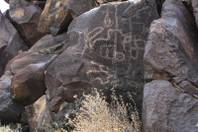
Sloan Canyon Petroglyph Site, 5500-3000 BC
Sloan Canyon’s rock art and archaeological features suggest human presence on the valley’s southeast edge going back to the Middle Archaic period (see date range above), with other elements from the Late Archaic, Puebloan and Late Prehistoric. The Sloan Canyon Petroglyph Site has hundreds of panels bearing figurative and abstract forms carved or chipped into the rock.
-

Old Mormon Fort, 1855
Mormon missionaries built an adobe fort in what is now downtown Las Vegas — the first permanent structure in the valley. The Old Mormon Fort was a travelers’ way station until the site was abandoned after two years and developed into a ranch in 1865. In 1929, the U.S. Bureau of Reclamation leased and renovated the fort as a testing lab and office during the construction of Hoover Dam. Today, it’s a sleepy tourist attraction.
-
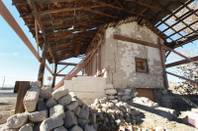
Kiel Ranch, 1875
The 240-acre Kiel Ranch homestead was settled by Conrad Kiel in current-day North Las Vegas. In the ’40s and ’50s, the renamed Boulderado Ranch became a haven for outsiders seeking quickie divorces. A $2 million restoration of 7 acres began in 2015, and the park project opened in June, showcasing an old adobe structure and wooden “Doll House” shed. The park might have been larger, as the city’s plan for it goes back to 1976, when 26 acres were donated by the North Las Vegas Bicentennial Committee. But for various reasons, it didn’t pan out.
-
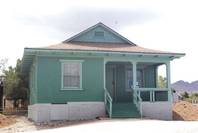
Railroad Cottage, 1909
Among Heritage Street’s collection of restored Las Vegas buildings, the Railroad Cottage is a toothpaste-green beacon moved from its original lot on Third Street. The 763-square-foot home was made with concrete, meant to keep it cool during the summer. It reopened to the public in 2013, complete with a teensy stove.
-
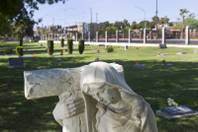
Woodlawn Cemetery, 1914
The original 10-acre parcel gifted by the Union Pacific Railroad to the city of Las Vegas for its first municipal cemetery has grown into the 40-acre Woodlawn Cemetery complex. The earth within holds outlaw miners and Civil War veterans, politicians, farmers and even the famous high roller Nick “The Greek” Dandolos.
-

Westside School, 1923
The first branch of the Las Vegas Grammar School is the oldest schoolhouse in Las Vegas, and was the first to integrate black students and Native American students from the nearby Paiute tribe. Ground was broken on a $12.5 million renovation of the Westside School in early 2015, and this year, it will reopen with a museum component boasting oral-history elements and memorabilia.
-
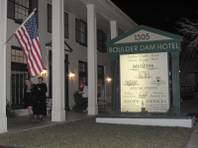
Boulder Dam Hotel, 1933
Built to provide upscale accommodations for dignitaries visiting the massive dam project outside of Las Vegas, the Boulder Dam Hotel is well preserved, from the stark white bricks and columns outside to the beautifully crafted wood paneling inside.
-
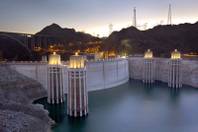
Hoover Dam, 1935
Hoover Dam might be outside the city, but it’s one of Las Vegas’ signature tourist attractions. The dam on the border of Nevada and Arizona is a sanctuary of art deco and a marvel of human engineering. Per history.com: “Approximately 5 million barrels of cement and 45 million pounds of reinforcement steel had gone into what was then the tallest dam in the world, its 6.6 million tons of concrete enough to pave a road from San Francisco to New York City.”
-
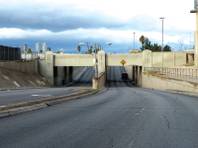
Bonanza Underpass, 1937
It might look like a plain concrete bridge, but the formerly named Clark Avenue Railroad Underpass was built by President Franklin D. Roosevelt’s Works Progress Administration to allow safer travel beneath the Union Pacific Railroad tracks that once cut Las Vegas off from settlements to the west.
-
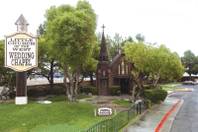
Little Church of the West, 1943
“Las Vegas wedding chapels started here!” crows the website of the Little Church of the West, which reportedly has hosted 50 ceremonies a week since the first one, including the weddings of famous couples such as Mickey Rooney and Betty Grable, and Angelina Jolie and Billy Bob Thornton. The cedar chapel was modeled after a California mining church and has been moved three times over the years.
-
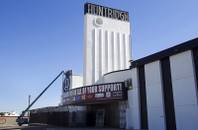
Huntridge Theater, 1944
Loved by the community, the S. Charles Lee-designed Huntridge Theater may still have to make way for commercial development. Since the venue’s closure in the ’90s, unsuccessful efforts to fund its preservation have ranged from state grants to crowdfunding campaigns.
-
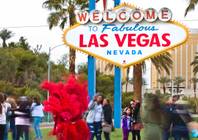
“Welcome to Fabulous Las Vegas” sign, 1959
Betty Willis’ glowing wonder, the “Welcome to Fabulous Las Vegas” sign, cost $4,000 — a “splurge” for the city, according to a 2015 New York Times article marking the designer’s death at age 91. It went on to note: “A proposal to demolish the sign in 1993 as an anachronism prompted a public outcry. In 2009, it was placed on the National Register of Historic Places as the ‘best-preserved and indeed the most iconic expression of the remarkable ascendancy of postwar Las Vegas and its famous strip.’”













Join the Discussion:
Check this out for a full explanation of our conversion to the LiveFyre commenting system and instructions on how to sign up for an account.
Full comments policy